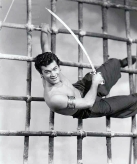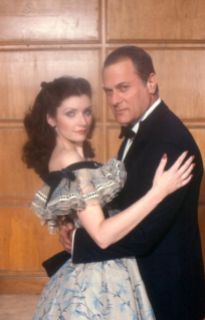
“My father was a tailor. I used to deliver for him. I’d have to hold the clothes up high to keep them from dragging on the ground.” –Tony Curtis
Tony Curtis enjoyed a long film career, in addition to appearing in the beloved comedy, Some Like It Hot (1959). Showcasing his acting skills in dramatic roles as well as the comical, he would become a major film star in the 1950s and 1960s.
Curtis was born Bernard Schwartz on June 3, 1925. His parents were of Hungarian-Jewish descent, later moving to New York. Schwartz would be the first of their three boys, born in Manhattan. In fact, Schwartz spoke Hungarian until the age of six.
While growing up, Schwartz’s parents struggled to make ends meet. Though his father worked as a tailor, Schwartz and his brothers—Julius and Robert—were placed in an orphanage when Schwartz was eight years old. Four years later, Julius passed away after being hit by a truck. Schwartz was part of a neighborhood gang until one of his neighbors sent him to Boy Scout camp.
During his teenage years, Schwartz attended Seward Park High School. He also expressed an interest in acting, participating in the school’s drama productions.
Soon after, he enlisted in the U.S. Navy after being influenced by Cary Grant’s performance in Destination Tokyo (1943). He worked aboard a submarine tender until the end of the war.
After his service, he enrolled at the City College of New York. He went on to study acting at The New School in Greenwich Village, leading him to be discovered by Joyce Selznick—casting director, agent, and niece of producer David O. Selznick.
Once he moved to Hollywood, Schwartz was placed under contract at Universal Pictures. He also adopted the stage name of Anthony Curtis, drawing from the novel Anthony Adverse and the Kurtz surname from his mother’s side of the family.
He made his film debut in Criss Cross (1949), fulfilling an uncredited role as a rumba dancer who danced with Yvonne de Carlo. He would be credited as Anthony Curtis in City Across the River (1949). As his time in films went on, he carried out several small roles in addition to appearances in Western films. He gained many fans during this period and was eventually given the chance to appear in a starring role in The Prince Who Was a Thief (1951) alongside Piper Laurie. The film was a box office success and proved to be a breakthrough role for Curtis.
Following The Prince Who Was a Thief, Curtis appeared in a variety of films, including Houdini (1953) and The Perfect Furlough (1958) with then-wife Janet Leigh. He worked on several B-movies in addition to the musical So This Is Paris (1955). He would later secure stronger roles in Trapeze (1956) with Burt Lancaster and Gina Lollobrigida and The Vikings (1958) with Kirk Douglas. He also worked on Kings Go Forth (1958) with Frank Sinatra and Natalie Wood. His appearance in The Defiant Ones (1958) would earn him an Oscar nomination.
In 1959, Curtis co-starred with Jack Lemmon and Marilyn Monroe in the Billy Wilder film Some Like It Hot. The film was a box office success and was followed by another comedy entitled Operation Petticoat (1959). Curtis and Leigh would work together once more in Who Was That Lady? (1960) with Dean Martin.
In the 1960s, Curtis focused upon working in more comedies. His output included Goodbye Charlie (1964) with Debbie Reynolds and Sex and the Single Girl (1964) with Wood. Both Wood and Lemmon would work with Curtis again in The Great Race (1965). By 1968, he sought a new acting challenge in the drama The Boston Strangler (1968), which received praise from critics and audiences.
Later in his career, Curtis appeared on television while still continuing to work in films. He carried out a supporting role in Sextette (1978) with Mae West, in addition to Little Miss Marker (1980) and The Scarlett O’Hara War (1980).
Off-screen, Curtis pursued his interest in painting—a hobby that would eventually command more of his attention as he transitioned out of the film industry. Curtis would also turn to writing, publishing American Prince: A Memoir in 2008 and The Making of Some Like It Hot: My Memories of Marilyn Monroe and the Classic American Movie in 2009.
Curtis also devoted his time to various philanthropic efforts. He and one of his daughters, Jamie Lee Curtis, worked to help finance the rebuilding of the Great Synagogue in Budapest, Hungary. He also founded the Emanuel Foundation for Hungarian Culture, which works to restore and preserve synagogues.
After suffering from lung problems and additional complications from smoking, Curtis passed away in his Henderson, Nevada, home on September 29, 2010. He was 85 years old. Curtis was buried at Palm Memorial Park in Henderson.
Today, Curtis’s legacy is remembered in many different locations.
Curtis was born at The Flower Fifth Avenue on 105th St. in New York. By 1930, his family was living at 1110 E. 165th St. in the Bronx. Both structures no longer stand. His 1950 home at 11831 Folkstone Ln. in Los Angeles has also been razed since his time there.

His Holmby Hills home, the Owlwood Estate, remains at 141 S. Carolwood Dr.

Curtis attended Seward Park High School, which is now the Seward Park Campus, located at 350 Grand St. in New York City.

Curtis considered Henderson, Nevada, his adopted hometown. Today, Tony Curtis Ln. is named after him in the Sun City Anthem housing development.

His final home, located at 2598 Forest City Dr., also stands in Henderson.

Curtis’s paintings are housed in galleries around the world, including at the Tony Vanderploeg Gallery in Carmel, California.
Additionally, Curtis was honored with a star on the Hollywood Walk of Fame, located at 6817 Hollywood Blvd.

While various tributes to Curtis exist to this day, he is best remembered for his film roles and the joy he brought audiences through them.
This post originally appeared in Annette’s Hometowns to Hollywood column for TCM Backlot. View the original article here.




































Pingback: Some Like It Hot (1959) | Hometowns to Hollywood
Pingback: Gary Cooper: Enduring Style | Hometowns to Hollywood